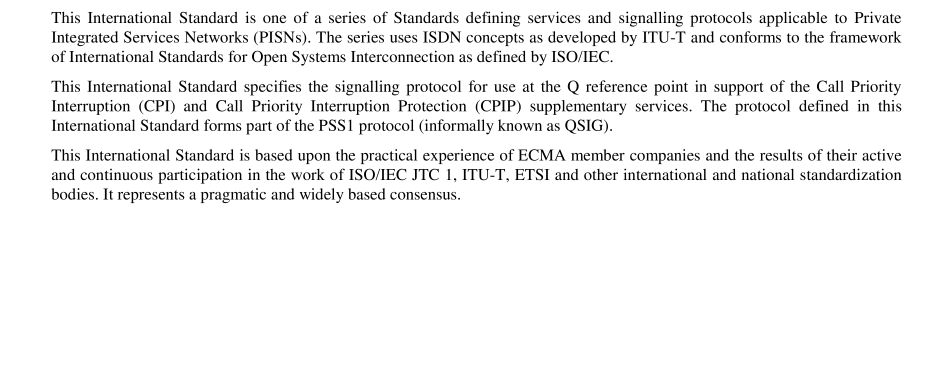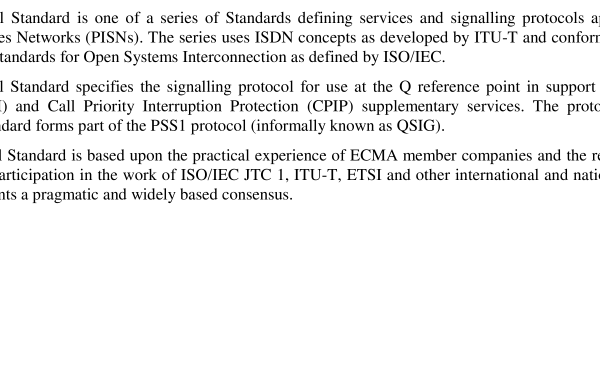ISO IEC 15992:2003 pdf download – Information technology — Telecommunications and information exchange between systems — Private Integrated Services Network — Inter-exchange signalling protocol — Call Priority Interruption and Call Priority Interruption Protection supplementary services.
1 Scope This International Standard specifies the signalling protocol for the support of the Call Priority Interruption (SS-CPI) and Call Priority Interruption Protection (SS-CPIP) supplementary services at the Q reference point between Private Integrated services Network eXchanges (PINXs) connected together within a Private Integrated Services Network (PISN). NOTE 1 – This edition of this International Standard does not apply to calls using the circuit-mode multiple rate bearer service. SS-CPI allows a call request for a priority call to proceed successfully in the case that there is no user information channel available. This is accomplished by force releasing an established call of lower priority. SS-CPIP allows for the protection of calls against interruption from priority calls. The Q reference point is defined in ISO/IEC 11579-1. Service specifications are produced in three stages and according to the method specified in ETS 300 387. This International Standard contains the stage 3 specification for the Q reference point and satisfies the requirements identified by the stage 1 and stage 2 specifications in ISO/IEC 15991. The signalling protocol for SS-CPI(P) operates on top of the signalling protocol for basic circuit switched call control, as specified in ISO/IEC 11572, and uses certain aspects of the generic procedures for the control of supplementary services specified in ISO/IEC 11582. This International Standard also specifies additional signalling protocol requirements for the support of interactions at the Q reference point between SS-CPI(P) and other supplementary services and ANFs. NOTE 2 – Additional interactions that have no impact on the signalling protocol at the Q reference point can be found in the relevant stage 1 specifications. This International Standard is applicable to PINXs that can interconnect to form a PISN. 2 Conformance In order to conform to this International Standard, a PINX shall satisfy the requirements identified in the Protocol Implementation Conformance Statement (PICS) proforma in annex A. Conformance to this International Standard includes conforming to those clauses that specify protocol interactions between SS-CPI(P) and other supplementary services and ANFs for which signalling protocols at the Q reference point are supported in accordance with the stage 3 standards concerned.
4.2 Called user
The user that receives a request to accept an incoming call and who may request SS-CPIP.
4.3 Calling user
The user that originates a call attempt and who may request SS-CPI and/or SS-CPIP.
4.4 Call interruption
An invocation procedure of SS-CPI whereby the calling user indicates that a “priority call” is to be made.
4.5 Call Priority Interruption Capability Level (CPICL)
A parameter indicating the priority of a call.
4.6 Call Priority Interruption Protection Level (CPIPL)
A parameter indicating a level of protection of a call against interruption from other calls.
4.7 Call protection
An invocation procedure of SS-CPIP whereby the calling user or the called user indicates that a call is to be protected.
4.8 Established call
The active call that is selected for interruption.
ISO IEC 15992:2003 pdf download – Information technology — Telecommunications and information exchange between systems — Private Integrated Services Network — Inter-exchange signalling protocol — Call Priority Interruption and Call Priority Interruption Protection supplementary services






